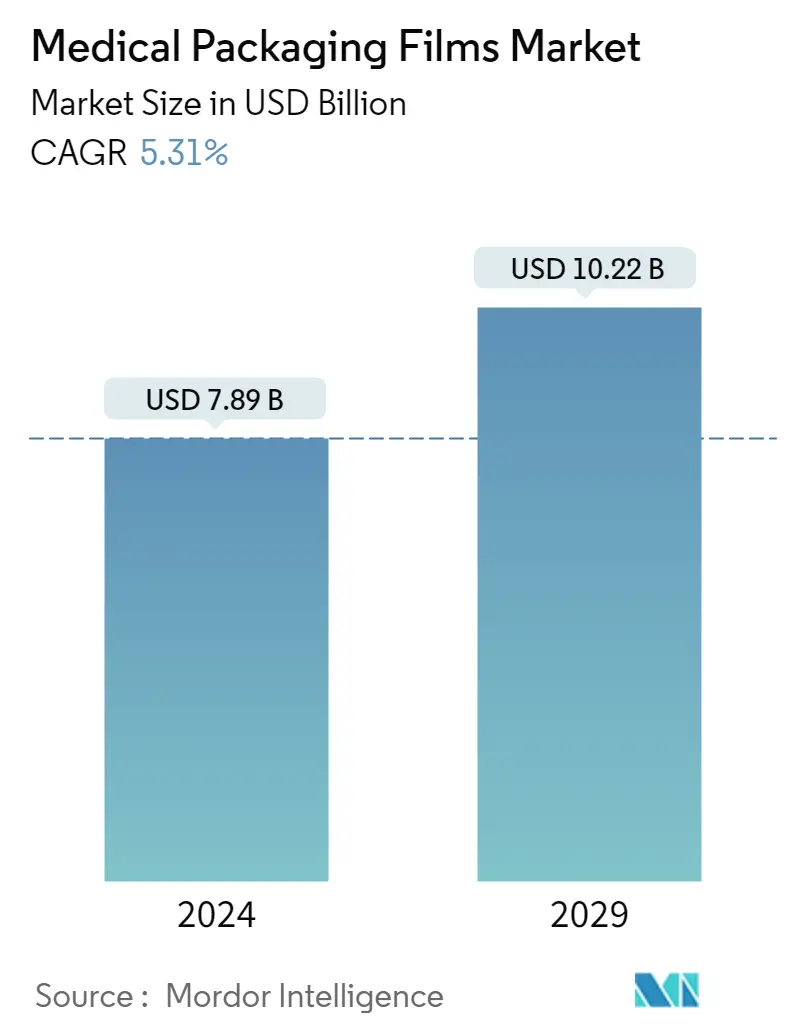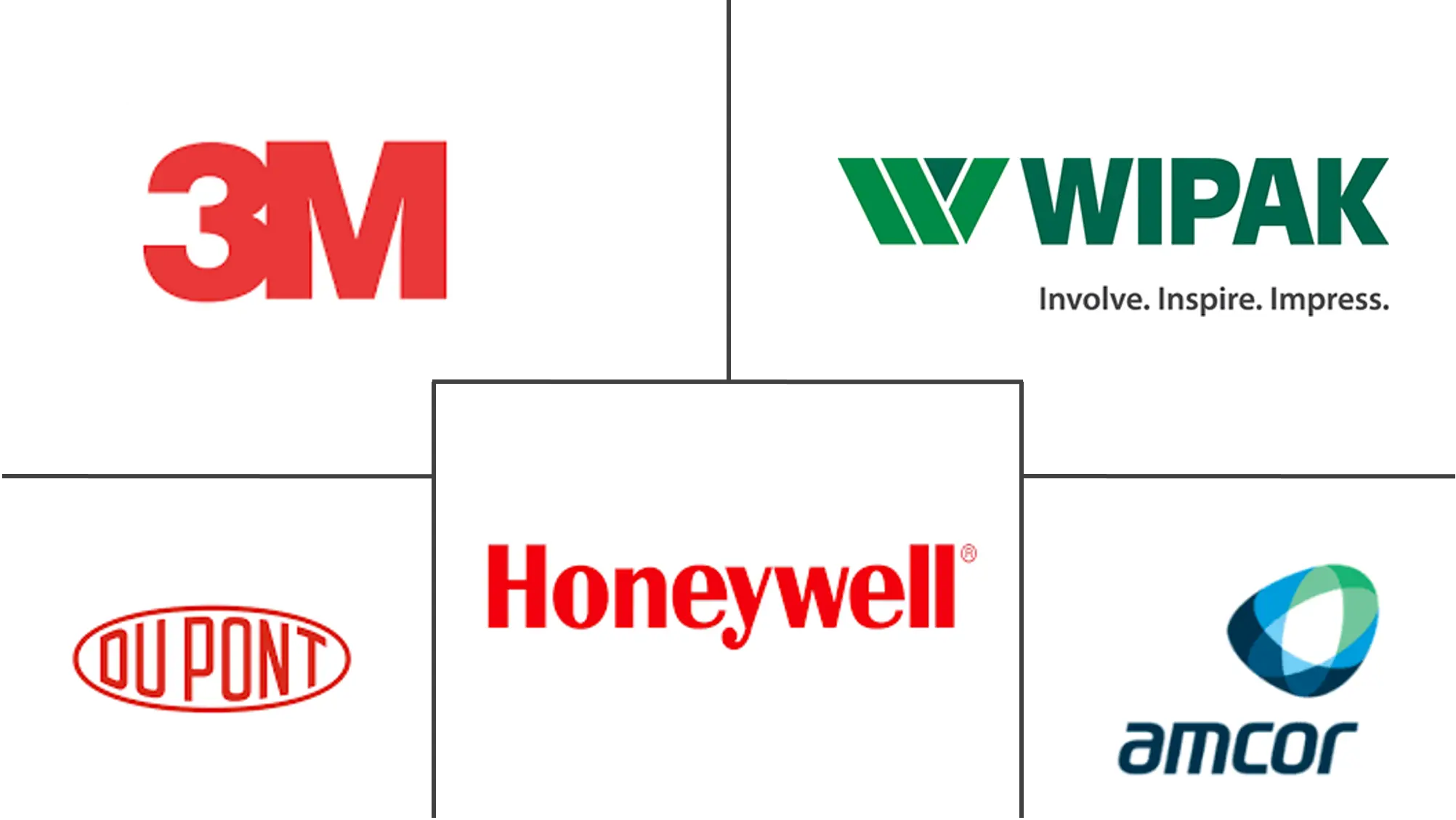Market Size of Medical Packaging Films Industry

| Study Period | 2019 - 2029 |
| Market Size (2024) | USD 7.89 Billion |
| Market Size (2029) | USD 10.22 Billion |
| CAGR (2024 - 2029) | 5.31 % |
| Fastest Growing Market | Asia Pacific |
| Largest Market | North America |
| Market Concentration | Low |
Major Players
*Disclaimer: Major Players sorted in no particular order |
Medical Packaging Films Market Analysis
The Medical Packaging Films Market size is estimated at USD 7.89 billion in 2024, and is expected to reach USD 10.22 billion by 2029, growing at a CAGR of 5.31% during the forecast period (2024-2029).
The market size reflects the value of packaging film products across medical packaging industry applications and is computed in the real term. Packaging films are made from plastic materials, such as polyethylene, polypropylene, biaxially oriented polyethylene terephthalate, polyphenylene ether, polyvinyl chloride, EVOH, polystyrene (PS), nylon, and various metals are considered as per the scope of the market study.
- Governments worldwide are heavily investing in medical and pharmaceutical products and solutions in damage control and the prevention of any potential resurgence of the COVID-19 pandemic. For instance, according to the Institute for Health Metrics and Evaluation (IHME), published in September 2021, the global per capita health expenditure was USD 1,129 in 2019, and it is projected to increase to USD 1,515 by 2050. Innovative packaging and preemptive measures are expected to become the norm in the medical industry, driving the demand for medical packaging films.
- The market studied is a burgeoning segment of the packaging sector, with many drivers accelerating the growth amid the challenges in the form of supply chain security woes, changing regulatory demands, and supply and demand imbalances. During the forecast period, bioplastic films are expected to increase their share on account of several initiatives taken by various market entities to curb the use of plastic materials. However, owing to the severe nature of the market studied, these initiatives are likely to have less impact on replacing plastic films with sustainable packaging films compared to other end-user industries of plastic films, thereby sustaining the market growth.
- The market is expected to experience significant growth, owing to the increase in therapeutics for chronic illnesses, such as cancer and the increasing demand for pouches, bags, and sachets for therapeutic medicines. Additionally, the aging population and the incidence of diabetes are projected to present new opportunities for market expansion.
- Some of the major challenges for the market growth are the volatility of raw material prices, the ongoing drive for sustainability, which includes replacing plastic-based packaging products with biodegradable materials, and mandates of using post-consumer recycled (PCR) plastics in plastic packaging. Usually, raw material costs are attributed to 55-60% of sales in this industry. Therefore, profitability is vulnerable to volatility in raw material prices. The key input cost for flexible packaging film is crude derivatives, which have been inherently volatile.
- During the COVID-19 pandemic, packaging film manufacturers were flooded with a pool of issues that lasted long for nearly one or two years. Some of the effects of lockdown included supply chain disruptions, labor shortages, lack of availability of raw materials used in the manufacturing process, fluctuating prices that caused the production of the final product to inflate and go beyond budget, transportation problems, etc.
Medical Packaging Films Industry Segmentation
Medical packaging films are used for a wide range of medical and pharmaceutical products, such as tablets, pills, capsules, implantable devices, unit dose medications, and diagnostic test kits in bags and pouches, with mostly plastic film packaging and sometimes metallic films based on the requirement of applications.
The scope of the study focuses on the market sizing encompassing packaging film product consumption and analyzing the medical packaging films market (henceforth referred to as the market studied). The study also tracks the key market parameters, underlying growth influencers, and major vendors operating in the market studied. This supports the market estimations and growth rates over the forecast period. The study further analyzes the overall impact of the COVID-19 pandemic on the ecosystem.
| Material Type | ||||||
| ||||||
| Metallic Film |
| Application | |
| Bags & Pouches | |
| Tubes | |
| Other Applications |
| Geography | |
| North America | |
| Europe | |
| Asia Pacific | |
| Latin America | |
| Middle East and Africa |
Medical Packaging Films Market Size Summary
The Medical Packaging Films Market is poised for substantial growth over the forecast period, driven by increasing investments in medical and pharmaceutical sectors globally. This growth is fueled by the rising demand for innovative packaging solutions that ensure the safety and longevity of medical products, particularly in the wake of the COVID-19 pandemic. The market is characterized by the use of various plastic materials, including polyethylene and polypropylene, which are essential for creating packaging films that meet the stringent requirements of the medical industry. Despite challenges such as supply chain disruptions and fluctuating raw material prices, the market is expected to expand, with bioplastics gaining traction as a sustainable alternative to traditional plastic films. The aging population and the prevalence of chronic illnesses like diabetes and cancer are further propelling the demand for medical packaging films, as these films are crucial for packaging therapeutic medicines and medical devices.
Regionally, the Asia-Pacific market is anticipated to experience the highest growth rate, driven by the burgeoning middle-class population and increasing disposable incomes in countries like China and India. The region's robust pharmaceutical production and the rising demand for implantable devices are key factors contributing to this growth. The shift towards domestically produced high-value medical devices in China, coupled with the aging demographic, is expected to significantly boost the demand for medical packaging films. Major players in the market, such as Honeywell and Amcor, are actively engaging in strategies like product innovation and partnerships to enhance their market presence. The focus on sustainability is evident, with companies introducing recyclable and bio-based packaging solutions to meet the evolving regulatory and consumer demands.
Medical Packaging Films Market Size - Table of Contents
-
1. MARKET INSIGHTS
-
1.1 Market Overview
-
1.2 Industry Attractiveness - Porter's Five Forces Analysis
-
1.2.1 Bargaining Power of Suppliers
-
1.2.2 Bargaining Power of Buyers
-
1.2.3 Threat Of New Entrants
-
1.2.4 Threat of Substitute Products
-
1.2.5 Intensity of Competitive Rivalry
-
-
1.3 Industry Value Chain Analysis
-
1.4 Assessment of the Impact of COVID-19 on the Market
-
-
2. MARKET SEGMENTATION
-
2.1 Material Type
-
2.1.1 Plastic Film
-
2.1.1.1 PE
-
2.1.1.2 PP
-
2.1.1.3 PVC
-
2.1.1.4 PC
-
-
2.1.2 Metallic Film
-
-
2.2 Application
-
2.2.1 Bags & Pouches
-
2.2.2 Tubes
-
2.2.3 Other Applications
-
-
2.3 Geography
-
2.3.1 North America
-
2.3.2 Europe
-
2.3.3 Asia Pacific
-
2.3.4 Latin America
-
2.3.5 Middle East and Africa
-
-
Medical Packaging Films Market Size FAQs
How big is the Medical Packaging Films Market?
The Medical Packaging Films Market size is expected to reach USD 7.89 billion in 2024 and grow at a CAGR of 5.31% to reach USD 10.22 billion by 2029.
What is the current Medical Packaging Films Market size?
In 2024, the Medical Packaging Films Market size is expected to reach USD 7.89 billion.

